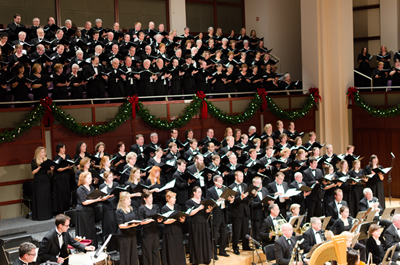Music lost in the Holocaust performed in the recently restored Duke Chapel by a polished ensemble accompanied by the chapel organist? Sign me up. Duke Performances hosted the South Dakota Chorale in an evening of wonderful rediscovery. The recently unearthed sacred works of Marcel Tyberg (1893 – 1944) headlined the evening, and proved well worthy of the marquee spot.
South Dakota Chorale is young by professional ensemble standards. Only five years old, and yet in that time, they have developed a characteristic sound with a strong sense of identity under the directorship of Brian Schmidt – one familiar with their work could recognize this choir from mere seconds of a recording. Their diction was stellar – especially Hebrew consonants. They also have a gentleman alto, which in addition to adding a nice timbre to the section, is just straight up seriously cool. The chorale was joined by Duke Chapel’s recently appointed organist Christopher Jacobson.
Not only did the concert feature an ensemble with a unique sound, but also some unique programmatic choices. Featured composer Tyberg is one of those artists whose music ended up on the unlucky side of history. After his tragic death at Auschwitz, Tyberg’s music gathered dust for decades. While some of his symphonies have been recently recorded, his sacred works have only recently been brought to light by Schmidt. Neither mass on the program has yet been published; even the recordings by the SD Chorale have not yet been released.
Tyberg’s sacred works are meticulously tailored to richly fulfill both their sacred and their practical purposes. His music is, in some ways, typical of many composers of his time, with neo-Romantic elements and nods to nationalistic and ethnic melodies. The Messe di Fascile in Fa Maggiore (Easy Mass in F Major) was clearly designed to provide rich musical material to church choirs of all abilities, from those of modest talent to the highest echelons. The Sanctus from this mass is a masterpiece of loveliness and simplicity. Replete with rich, dynamic illustration of the text, these works incorporate traditional Gregorian chant melodies and highlight the emotional and theological implications of the text without demanding too many technical fireworks of the musicians. The Messe in Sol Maggiore (Mass in G Major) was richly complex in comparison, and incorporated a heartfelt soprano solo in the unusual Phrygian mode. Local choirs should be on the lookout for publication of these scores – especially for the Easy Mass in F Major.
Given the relative obscurity of both of the composers on the concert, the lack of any information resembling program notes proved a little aggravating for the more curious audience members. Considering that Duke’s music program has established such a marked niche in musicology, it was disappointing to have to independently dig up information from questionable sources after attending a concert at such a historically-focused institution.
The third piece on the program was Eric Zeisl’s Requiem Ebraico: the 92nd Psalm. Technically the first piece of Classical music written in remembrance of Holocaust victims, it is a sweeping, deeply emotional work. Schmidt approached it with a discipline that allowed for the power of the music itself to be the star, rather than shifting the emphasis to a lush, over-dramatic interpretation. The duet between Jennifer Youngs, soprano, and Elizabeth Knight, mezzo soprano, featured a vocal blend that reminded the listener of a good wine pairing in its complementarity. Baritone Brandon Hendrickson presented two technically polished and emotionally intense solos – very much the highlight of the Requiem.
Balance was an issue throughout the evening, but the performers could not necessarily be faulted for this issue. Duke Chapel is enormously resonant in lower registers; with such a powerful organ at his disposal, it is not surprising that Jacobson would want to take full advantage of the timbres at his disposal. Unfortunately, the acoustics of the space magnified the sheer volume of the organ as to distort the balance in all but the pianissimo passages. While Duke Chapel is a stunning, historic, and unique performance space, its acoustic peculiarities hindered this particular instrumentation. This same program with the same performers would have been better served in a smaller room with an instrument that does not regularly shake the pews.
The warmth and approachability of the ensemble members following the enthusiastic applause did not go unnoticed. They acted as advocates for the music and for their ensemble, and professionally provided the personal touch that will make audience members (especially younger ones) keep coming back. In spite of the challenges presented by the venue, it was a memorable evening full of inspiring music created by thoughtful performers.
The Duke Performances series features some special and unusual programs in the coming months. Please stay informed so you don’t miss anything – that’s what the CVNC calendar is for.











